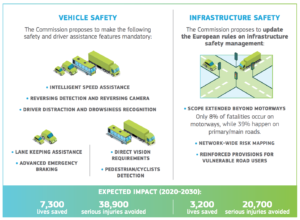President Juncker has steered the course of action of this Commission towards a Europe that protects. Safety is fundamental to any transport system and must always be the top priority. Thanks to actions at EU, national and local levels, road safety in the EU has greatly improved in recent decades.
President Juncker: “Our roads are the safest in the world. We cannot however afford to be complacent. Progress in reducing EU-wide road fatalities has stagnated in recent years, and the EU objective of halving road fatalities between 2010 and 2020 is now an extreme challenge. This calls for fresh efforts from all actors to make European roads safer”.
Road safety is a responsibility shared between the EU and the Member States. The Commission focuses on actions with strong EU added-value and is today proposing a new policy framework for 2021-2030. It confirms the EU’s long-term goal of moving close to zero fatalities and serious injuries by 2050 (“Vision Zero”), with an interim target of minus 50% between 2020 and 2030.
To help achieve these targets, the Commission is presenting:
- Two legislative initiatives on vehicle and pedestrian safety, and on infrastructure safety management.
- An EU Strategic Action Plan on Road Safety identifying additional measures.
- A Communication on connected and automated mobility systems.
In support of these actions, the Commission is making an additional €450 million available under the Connecting Europe Facility to support projects in the Member States contributing to road safety, digitisation and multimodality
The Commission works on the basis of the internationally recognised “safe system” approach, which accepts that people make mistakes and aims to ensure that this does not lead to fatalities or serious injuries. The safety of all parts of the system therefore needs to be improved – roads and roadsides, speeds, vehicles, road use – so that if one element fails, another will compensate.
The proposals by the Commission focus on vehicle and infrastructure safety. They build on the positive experience of existing mandatory safety measures and on the emergence of new technologies.
In addition to these immediately actionable proposals, the Commission is looking ahead and offering a mid-term vision on automated mobility, with safety at its core. Increasing degrees of automation offer significant potential to compensate for human errors and thereby improve road safety. Yet the technology also brings new safety challenges that need to be addressed.
The Commission presents a comprehensive strategy to help the EU, Member States and stakeholders to work together to ensure that the EU seize the opportunities brought by driverless mobility and at the same time anticipate challenges on society in order to mitigate them.
Source: EU

